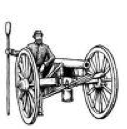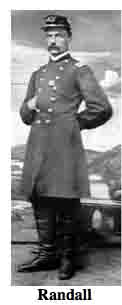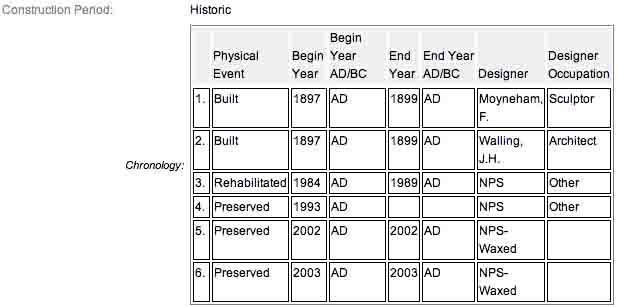
The 16th Vermont Infantry served as a member of Stannard’s Brigade in Doubleday’s Division of the First Corps, Army of the Potomac. The 13th Regiment, Vermont Volunteer Infantry (or 13th VVI) was a nine months' infantry regiment in the Union Army during the American Civil War. It served in the eastern theater, predominantly in the Defenses of Washington, from October 1862 to August 1863. It was a member of the 2nd Vermont Brigade. he 13th, 14th and 16th Vermont Regiments played a pivotal role in the Union repulse of Pickett's Charge on the afternoon of July 3.
The unit was commanded by Colonel Francis V. Randall (1824-1885). Randall was a member of state legislature and also a pre-war lawyer and postmaster from Montpelier. Francis Voltaire Randall, son of Gurdon R. and Laura Scott (Warner) Randall, was born in Braintree, Vt., February 13, 1824. At the battle of Gettysburg, July 1-4, 1863, the 13th Vermont lead by its gallant colonel, rendered conspicuous service and gained for themselves an immortal name in the war history of our country for the gallantry displayed in this decisive battle. Notable, during the second day's fight, Colonel Randall, at the request of General Hancock, recaptured a battery that had been lost to the Confederates and turned with terrible effect upon our own men who had been unable to silence it For their gallantry in this heroic charge, General Hancock personally and on the field, complimented Colonel Randall and his command. To this regiment belongs the distinction of repulsing General Pickett's famous charge in this battle. He was mustered out of service, July 21, 1863, and began immediately to recruit the 17th Vermont Volunteers; was commissioned its colonel, February 10,1864; served with distinction in the battles of the Wilderness, the siege of Petersburg and the capture of Lee's army, and finally was mustered out of the service, July 14, 1865. After the war he resumed his law career and frequently letured on the Battle of Gettysburg. Randall died in Northfield, Vt., March 1, 1885. He was buried in Elmwood Cemetery, Northfield, where a granite shaft, set up by his comrades in arms in memory of their beloved leader, marks his resting place. SOURCE Under his command the 16th brought 710 men to the field and among them 10 were killed, 102 were wounded and 10 went missing.
The 13th Vermont Infantry 3rd Day Position Marker is located along  Hancock Avenue (RD310), on the left or east side of the road if traveling traveling north, 655 feet north (350°) of the
Hancock Avenue (RD310), on the left or east side of the road if traveling traveling north, 655 feet north (350°) of the  13th Vermont Infantry Monument (MN249-C) and 273 feet west (286°) of the
13th Vermont Infantry Monument (MN249-C) and 273 feet west (286°) of the  United States Regulars Monument (MN235) and seven feet to the right or east of the
United States Regulars Monument (MN235) and seven feet to the right or east of the  Union Counterthrust Interpretive. This area is an absolute beehive of activity as this site represents the best of what Gettysburg has to offer, both historically and monumentally.
Union Counterthrust Interpretive. This area is an absolute beehive of activity as this site represents the best of what Gettysburg has to offer, both historically and monumentally.  Parking is plentiful and is available road-side at intermittently enlarged shoulder cut-outs, usually marked with white striping. Be sure to keep vehicles off the grass or you will be ticketed by park police. I visited this monument on Monday, August 13, 2012 at approximately 4:10 P.M. I was at an elevation of 573 feet, ASL. I used a Canon PowerShot 14.1 Megapixel, SX210 IS digital camera for the photos.
Parking is plentiful and is available road-side at intermittently enlarged shoulder cut-outs, usually marked with white striping. Be sure to keep vehicles off the grass or you will be ticketed by park police. I visited this monument on Monday, August 13, 2012 at approximately 4:10 P.M. I was at an elevation of 573 feet, ASL. I used a Canon PowerShot 14.1 Megapixel, SX210 IS digital camera for the photos.
Often, state regiment monuments are also accompanied by secondary monument which designate positions maintained from July 1-3, 1863 as well as flank monuments to delineate the ends of troop lines. The primary  13th Vermont Infantry Monument (MN249-C) has three position marker for July 3, 1863, the only such occurrence of this many position markers for the same day for the same regiment I have found on the battlefield. The dedication dates for the primary and position markers are in conflict with the various sources I use. Suffice to say I am sure they ere erected and dedicated between 1896-1899. This markers is composed of granite, smoothish & rectangular-prism shaped, with a slanted front upon which rest the incised inscription. The marker is 1 foot 6 inches x 1 foot 8 inches x 3 feet 8 inches in height. Additional details from the nomination form concerning the flank monuments may be found below in red. The inscription reads:
13th Vermont Infantry Monument (MN249-C) has three position marker for July 3, 1863, the only such occurrence of this many position markers for the same day for the same regiment I have found on the battlefield. The dedication dates for the primary and position markers are in conflict with the various sources I use. Suffice to say I am sure they ere erected and dedicated between 1896-1899. This markers is composed of granite, smoothish & rectangular-prism shaped, with a slanted front upon which rest the incised inscription. The marker is 1 foot 6 inches x 1 foot 8 inches x 3 feet 8 inches in height. Additional details from the nomination form concerning the flank monuments may be found below in red. The inscription reads:
13th Vt.
F.V. Randall, Colonel
Right of Stannard's
Brigade
3d Position 3d Day
Struck Pickett's
flank here.
The 13th Vermont Infantry 3rd Day Position Marker and primary monument are contributing features to the Gettysburg National Military Park Historic District which is nationally significant under NR Criteria A, B, C & D. Areas of Significance: Military, Politics/Government, Landscape Architecture, Conservation, Archeology-Historic. Period of Significance: 1863-1938. The original National Register Nomination was approved by the Keeper March 19, 1975. An update to this nomination was approved by the Keeper on January 23, 2004. The position & primary monuments are collectively identified as structures number MN249-C.
From the Nomination Form:
1 of 6 Vermont monumnets. Indicates regiment position July 2, 1863. 3 Position Markers show regiment location July 3, 1863. Aided in repulse of Longstreet's assualt. Located E side Hancock, Pos Mkrs as follows: E of Mn, NW of Mn, N of US Reg Mn.
Short Physical Description:
Mn w/ 3 Position Markers. Base 8'sq. Stepped granite shaft w/excised inscription, bronze tablets & medallion. Topped w/ bronze statue of Lt. Stephen F. Brown. All 16'4"H. Position Markers 1'6"x1'8"x3'8"H w/ incised inscription.
Long Physical Description:
Monument that has three position markers. Monument is a stepped granite shaft topped with a bronze statue of Lt. Stephen F. Brown and set on an eight foot square base. The shaft has an excised inscription, bronze tablets, and a medallion. Overall height is 16.4 feet. Designed by J. H. Walling. Position markers are 1.6x1.8 foot with incised inscription. Monument located on the east side of Hancock Avenue. Position markers are to the east and northwest of the monument and north of the United States Regulars Monument.

My Sources
1.
NRHP Nomination Form
2.
SIRIS
3.
Stone Sentinels
4.
Virtual Gettysburg
5.
Draw the Sword
6.
Historical Marker Database
7.
Wikipedia